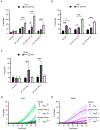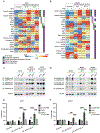SOX10 Loss Sensitizes Melanoma Cells to Cytokine-Mediated Inflammatory Cell Death
- PMID: 37847239
- PMCID: PMC10842433
- DOI: 10.1158/1541-7786.MCR-23-0290
SOX10 Loss Sensitizes Melanoma Cells to Cytokine-Mediated Inflammatory Cell Death
Abstract
The transcription factor, SOX10, plays an important role in the differentiation of neural crest precursors to the melanocytic lineage. Malignant transformation of melanocytes leads to the development of melanoma, and SOX10 promotes melanoma cell proliferation and tumor formation. SOX10 expression in melanomas is heterogeneous, and loss of SOX10 causes a phenotypic switch toward an invasive, mesenchymal-like cell state and therapy resistance; hence, strategies to target SOX10-deficient cells are an active area of investigation. The impact of cell state and SOX10 expression on antitumor immunity is not well understood but will likely have important implications for immunotherapeutic interventions. To this end, we tested whether SOX10 status affects the response to CD8+ T cell-mediated killing and T cell-secreted cytokines, TNFα and IFNγ, which are critical effectors in the cytotoxic killing of cancer cells. We observed that genetic ablation of SOX10 rendered melanoma cells more sensitive to CD8+ T cell-mediated killing and cell death induction by either TNFα or IFNγ. Cytokine-mediated cell death in SOX10-deficient cells was associated with features of caspase-dependent pyroptosis, an inflammatory form of cell death that has the potential to increase immune responses.
Implications: These data support a role for SOX10 expression altering the response to T cell-mediated cell death and contribute to a broader understanding of the interaction between immune cells and melanoma cells.
©2023 American Association for Cancer Research.
Conflict of interest statement
Figures





References
-
- Shakhova O, Zingg D, Schaefer SM, Hari L, Civenni G, Blunschi J, et al. Sox10 promotes the formation and maintenance of giant congenital naevi and melanoma. Nat Cell Biol 2012;14:882–890 - PubMed
-
- Dunn GP, Bruce AT, Ikeda H, Old LJ, and Schreiber RD. Cancer immunoediting: from immunosurveillance to tumor escape. Nat Immunol 2002;3:991–998 - PubMed
-
- Wouters J, Kalender-Atak Z, Minnoye L, Spanier KI, De Waegeneer M, Bravo González-Blas C, et al. Robust gene expression programs underlie recurrent cell states and phenotype switching in melanoma. Nat Cell Biol 2020;22:986–998 - PubMed
Publication types
MeSH terms
Substances
Grants and funding
LinkOut - more resources
Full Text Sources
Medical
Molecular Biology Databases
Research Materials

